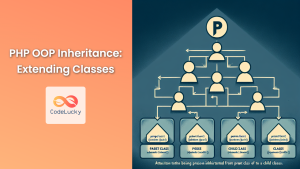PHP traits are a powerful feature that allows developers to reuse sets of methods freely in several independent classes. While the basic concept of traits is straightforward, their advanced usage and conflict resolution techniques can significantly enhance your object-oriented programming skills in PHP. In this comprehensive guide, we'll dive deep into the world of PHP traits, exploring advanced scenarios and providing practical solutions for common challenges.
Understanding PHP Traits
Before we delve into advanced usage, let's quickly recap what traits are in PHP. Traits are a mechanism for code reuse in single inheritance languages such as PHP. They are similar to classes, but are only intended to group functionality in a fine-grained and consistent way. It's not possible to instantiate a trait on its own.
Here's a simple example of a trait:
trait Logger {
public function log($message) {
echo date('Y-m-d H:i:s') . ': ' . $message . "\n";
}
}
This trait can be used in any class that needs logging functionality:
class User {
use Logger;
public function save() {
$this->log('User saved');
// Save user logic here
}
}
Now that we've refreshed our memory, let's explore some advanced concepts.
📊 Multiple Trait Usage
One of the powerful features of traits is the ability to use multiple traits in a single class. This allows for a high degree of code reuse and flexibility.
trait Serializable {
public function serialize() {
return serialize($this->data);
}
public function unserialize($data) {
$this->data = unserialize($data);
}
}
trait Loggable {
public function log($message) {
echo date('Y-m-d H:i:s') . ': ' . $message . "\n";
}
}
class User {
use Serializable, Loggable;
private $data = [];
public function save() {
$this->log('Saving user data');
$serialized = $this->serialize();
// Save $serialized to database
}
}
In this example, the User class benefits from both the Serializable and Loggable traits, enhancing its functionality without the need for complex inheritance structures.
🔄 Trait Composition
Traits can also use other traits, allowing for trait composition. This feature enables you to build more complex traits from simpler ones.
trait TimestampTrait {
public function getTimestamp() {
return date('Y-m-d H:i:s');
}
}
trait LoggerTrait {
use TimestampTrait;
public function log($message) {
echo $this->getTimestamp() . ': ' . $message . "\n";
}
}
class Application {
use LoggerTrait;
public function run() {
$this->log('Application started');
// Application logic here
}
}
In this example, LoggerTrait uses TimestampTrait, and Application class uses LoggerTrait, effectively inheriting methods from both traits.
🛠️ Conflict Resolution
When using multiple traits, you might encounter naming conflicts. PHP provides several ways to resolve these conflicts.
Precedence Rules
When a class uses multiple traits that define the same method name, PHP follows specific precedence rules:
- Methods defined in the class itself take precedence over trait methods.
- Methods from traits override inherited methods.
- If two traits insert a method with the same name, a fatal error is produced.
Let's see an example:
trait A {
public function smallTalk() {
echo "Trait A\n";
}
public function bigTalk() {
echo "A\n";
}
}
trait B {
public function smallTalk() {
echo "Trait B\n";
}
public function bigTalk() {
echo "B\n";
}
}
class Talker {
use A, B {
B::smallTalk insteadof A;
A::bigTalk insteadof B;
}
}
$talker = new Talker();
$talker->smallTalk(); // Outputs: Trait B
$talker->bigTalk(); // Outputs: A
In this example, we explicitly state that we want to use B::smallTalk instead of A::smallTalk, and A::bigTalk instead of B::bigTalk.
Aliasing
Another way to resolve conflicts is by aliasing trait methods. This allows you to rename a method when you use it in your class.
trait A {
public function smallTalk() {
echo "Trait A\n";
}
public function bigTalk() {
echo "A\n";
}
}
trait B {
public function smallTalk() {
echo "Trait B\n";
}
public function bigTalk() {
echo "B\n";
}
}
class Talker {
use A, B {
B::smallTalk insteadof A;
A::bigTalk insteadof B;
B::bigTalk as talk;
}
}
$talker = new Talker();
$talker->smallTalk(); // Outputs: Trait B
$talker->bigTalk(); // Outputs: A
$talker->talk(); // Outputs: B
Here, we've aliased B::bigTalk as talk, allowing us to use both A::bigTalk (as bigTalk) and B::bigTalk (as talk) in our Talker class.
🔒 Changing Method Visibility
PHP allows you to change the visibility of methods provided by a trait when you use them in your class. This can be particularly useful when you want to use a trait's method internally but don't want to expose it as part of your class's public API.
trait Sharable {
public function share($item) {
echo "Sharing: $item\n";
}
}
class PrivateSharer {
use Sharable {
share as private;
}
public function shareSecretly($item) {
$this->share("SECRET: $item");
}
}
$sharer = new PrivateSharer();
$sharer->shareSecretly("password"); // Outputs: Sharing: SECRET: password
// $sharer->share("password"); // This would cause an error
In this example, we've changed the visibility of the share method to private when using it in the PrivateSharer class.
🎭 Abstract Trait Methods
Traits can specify abstract methods that classes using the trait must implement. This is similar to abstract classes and can be used to define a "contract" that classes must fulfill.
trait Comparable {
abstract public function compare($other): int;
public function isEqualTo($other): bool {
return $this->compare($other) === 0;
}
public function isGreaterThan($other): bool {
return $this->compare($other) > 0;
}
public function isLessThan($other): bool {
return $this->compare($other) < 0;
}
}
class Number {
use Comparable;
private $value;
public function __construct($value) {
$this->value = $value;
}
public function compare($other): int {
if ($this->value == $other->value) return 0;
return ($this->value > $other->value) ? 1 : -1;
}
}
$a = new Number(5);
$b = new Number(3);
echo $a->isGreaterThan($b) ? "A is greater than B\n" : "A is not greater than B\n";
echo $a->isEqualTo($b) ? "A is equal to B\n" : "A is not equal to B\n";
echo $a->isLessThan($b) ? "A is less than B\n" : "A is not less than B\n";
Output:
A is greater than B
A is not equal to B
A is not less than B
In this example, the Comparable trait defines an abstract compare method and provides concrete implementations for isEqualTo, isGreaterThan, and isLessThan based on the compare method. The Number class then implements the compare method to fulfill the contract.
🏗️ Static Methods and Properties in Traits
Traits can also define static methods and properties. However, it's important to note that these are shared among all classes using the trait.
trait Counter {
private static $count = 0;
public static function incrementCount() {
self::$count++;
}
public static function getCount() {
return self::$count;
}
}
class A {
use Counter;
}
class B {
use Counter;
}
A::incrementCount();
A::incrementCount();
B::incrementCount();
echo "A count: " . A::getCount() . "\n"; // Outputs: A count: 3
echo "B count: " . B::getCount() . "\n"; // Outputs: B count: 3
As you can see, the $count property is shared between A and B, which might not always be the desired behavior. Be cautious when using static properties in traits.
🚀 Real-World Example: Building a Flexible Logging System
Let's put all these concepts together in a real-world scenario. We'll build a flexible logging system that can be easily integrated into different classes.
trait TimestampTrait {
private function getTimestamp() {
return date('Y-m-d H:i:s');
}
}
trait FilesystemTrait {
private function writeToFile($filename, $content) {
file_put_contents($filename, $content, FILE_APPEND);
}
}
trait LoggerTrait {
use TimestampTrait, FilesystemTrait;
private $logFile = 'application.log';
public function setLogFile($filename) {
$this->logFile = $filename;
}
public function log($message, $level = 'INFO') {
$logEntry = sprintf("[%s] [%s] %s\n", $this->getTimestamp(), $level, $message);
$this->writeToFile($this->logFile, $logEntry);
}
}
class User {
use LoggerTrait {
log as private writeLog;
}
private $name;
public function __construct($name) {
$this->name = $name;
$this->setLogFile('user.log');
}
public function save() {
// Save user logic here
$this->writeLog("User {$this->name} saved", 'INFO');
}
}
class Order {
use LoggerTrait;
private $orderId;
public function __construct($orderId) {
$this->orderId = $orderId;
$this->setLogFile('order.log');
}
public function process() {
// Process order logic here
$this->log("Order {$this->orderId} processed", 'INFO');
}
}
// Usage
$user = new User('John Doe');
$user->save();
$order = new Order('ORD-001');
$order->process();
In this example:
- We've created three traits:
TimestampTrait,FilesystemTrait, andLoggerTrait. LoggerTraitcomposes the other two traits to create a complete logging solution.- Both
UserandOrderclasses useLoggerTrait, but in slightly different ways:Userclass aliases thelogmethod towriteLogand makes it private.Orderclass uses thelogmethod as-is.
- Each class sets its own log file, demonstrating the flexibility of our logging system.
This setup allows for a highly flexible and reusable logging system that can be easily integrated into various parts of an application.
🎓 Conclusion
PHP traits are a powerful tool for code reuse and composition. By understanding advanced usage patterns and conflict resolution techniques, you can create more flexible, maintainable, and efficient code. Remember these key points:
- Traits allow for multiple inheritance-like behavior in PHP.
- You can use multiple traits in a single class.
- Traits can be composed of other traits.
- Conflict resolution techniques include precedence rules and aliasing.
- You can change method visibility when using traits.
- Traits can define abstract methods to create contracts.
- Be cautious with static properties in traits.
By mastering these concepts, you'll be well-equipped to leverage the full power of PHP traits in your projects. Happy coding! 🚀💻



















